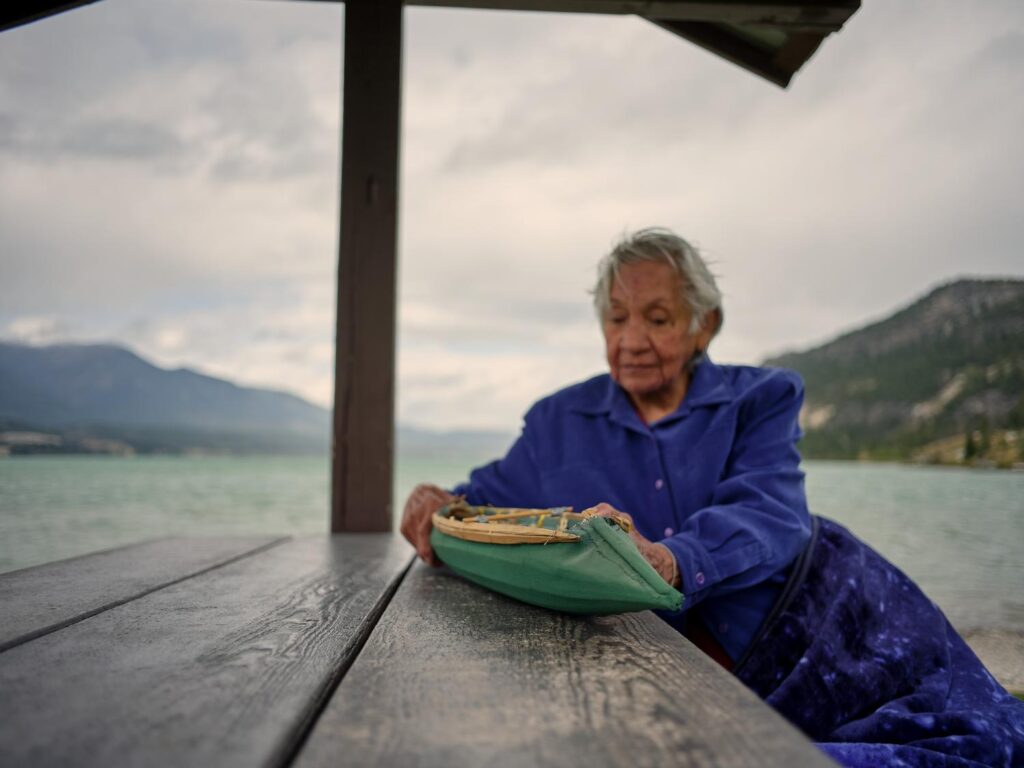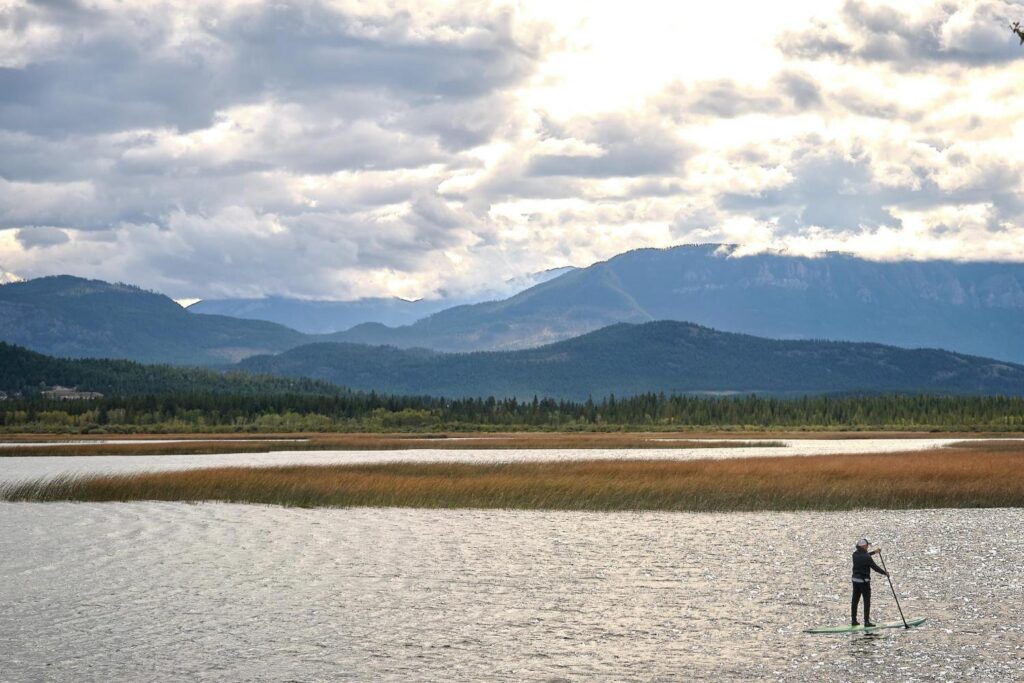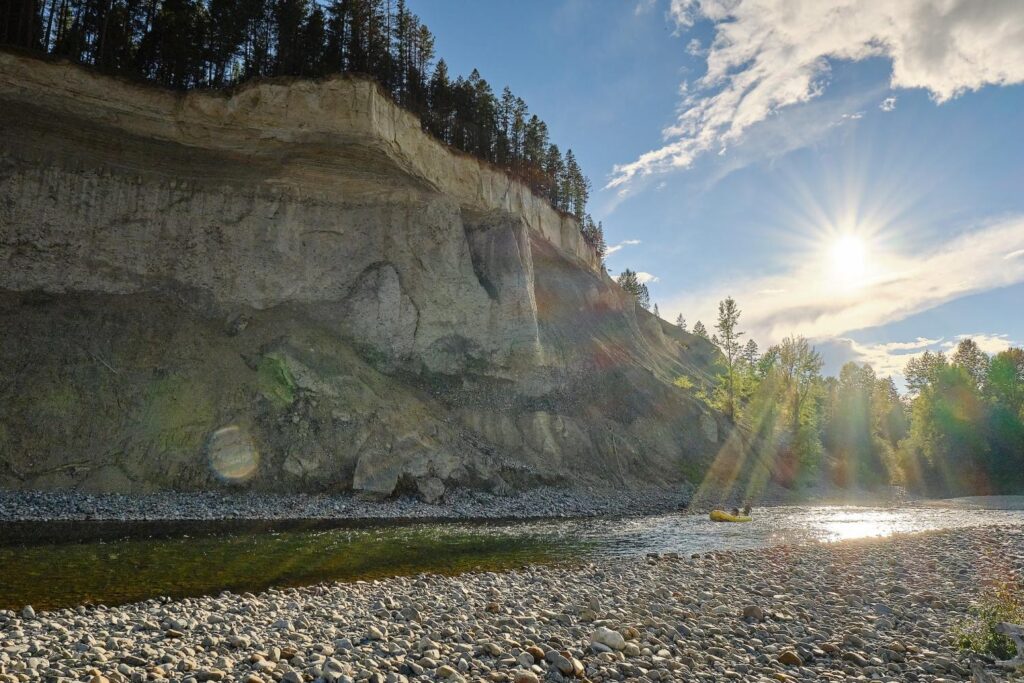Ktunaxa Creation Story Connects Water, Life
Since time beyond the reach of memory, the homelands of the Ktunaxa People were ruled by spirit animals. Yawuʔnik̓, a huge water monster, bothered many of the animals. With news of the human race coming to earth, it was decided by the chief spirit animal, Naⱡmuqȼin, that Yawuʔnik̓ must be killed. A Big Chase ensued. Yawuʔnik̓ swam the Kootenay and Columbia waterways, creating one of the world’s biggest continuous river systems. Eventually, Naⱡmuqȼin and his war party were victorious in his pursuit of Yawuʔnik̓, capturing the water monster and killing him.
Learn more about the creation story www.ktunaxa.org/who-we-are/creation-story/
History
Long before James Baker an English settler and Colonel Sam Steele, of the Northwest Police arrived in the Kootenay’s, the Ktunaxa people enjoyed ʔakisqakⱡiʔit without interference. ʔakisqakⱡiʔit was one of the many chosen farms and vacation sites Ktunaxa lived at different times of the year. It was free of mosquitos, had freshwater creeks and grazing for horses and other farm animals. The chief of the community was Chief Joseph who set up his home with a garden and horses that roamed freely throughout ʔakisqakⱡiʔit.
Before the settlers came the Ktunaxa and Ksanka, our people who are in what is now Montana, had attended a meeting with the Flathead and Pend O’Reille tribes in the southern Montana at a place called Council Grove Sacred Heart of Mary – Maⱡi Akiⱡwiy. The Blackrobe, who were the first group sent by the Queen to travel North America, told the ʔakⱡsmaknik (Red People) that “the white people were spilling into the country and taking up land. And, if they did not take up land that they would be chased into the mountains.” So, that is when the Ktunaxa/Ksanka group chose to move up to the northern part of their homeland.
The Ktunaxa knew there would be a large amounts of white people arriving to Ktunaxa ʔamakʔis (land) and knew things would change. The change affected the land. The Kootenay Land District were open to land settlement pre – emptions in 1868. As settlers made land purchases one parcel of land in particular, ʔakisqakⱡiʔit also referred to as Joseph’s prairie land, became an issue.
ʔakisqakⱡiʔit, Joseph’s Prairie, the area that was travelled and use by Ktunaxa before the coming of the white settlers, had been purchased and worked by a settler, Galbraith who eventually sold it to James Baker. Galbraith had an agreement with Chief Joseph which was the Ktunaxa could continue to use the land for their needs. However, Baker rejected the arrangement between Galbraith and the Chief Joseph. Chief Isadore, who was Chief Joseph’s step son who was handed the chieftainship to, were now forbidden to farm the land that was left to him by his stepfather Chief Joseph. Ktunaxa knowledge says that the issue became contentious when their homes and other implements were burned to the ground three times to force the Chief and his family from his land. This caused tension between Ktunaxa and settlers.
In 1884 two miners were found dead at Deadman’s Creek without leads to charge anyone for the murders, the Ktunaxa were under suspicion where two Ktunaxa men were arrested, Kapⱡa and Little Isadore being placed in a holding cell at Fort Steele. Colonel Sam Steele of the North West Mounted Police and his troupe were called in from Alberta to manage the growing discontent.
After many days of meetings with the Ktunaxa, Colonel Sam Steele and an Indian Reserve Commissioner who had been called in, a settlement was reached. Chief Isadore was able to take care of the matter of the two men and he accepted other Indian Reserve land in lieu of ʔakisqakⱡiʔit, Josephs’ Prairie.
We invite you to learn more about the Ktunaxa Homelands , please watch the videos below;
#KtunaxaHomelands Waterways Itinerary
Pulsing through the Kootenays, the waterways of Ktunaxa shape the landscape, the culture, and the spirit of all who swim, play, fish, paddle or simply go with the flow here. To many visitors, these waterways bring fun, recreation, relaxation and a sense of adventure.
But to the Ktunaxa people who have traveled in and occupied the area for more than 10,000 years, these waterways also bring survival, strength and nourishment.

The waterways—all lakes and rivers, sloughs and waterfalls—formed during the Big Chase, linking the Ktunaxa People to the waters and providing sustenance.
They fished these waters, travelled them, and used them for hunting, foraging, and ceremony. Ktunaxa relied heavily on boats to navigate the landscape, and created the unique and widely-admired sturgeon-nosed canoe to traverse Rocky Mountain swampy waterways.
As a visitor to this place, you are invited to connect to the #KtunaxaHomelands and the deeper significance to this place.
When you visit and adventure on these waters, you are invited to connect to the #KtunaxaHomelands and the deeper significance to this place.
Here is a water-based itinerary that you can do over three days or cherry pick your favourites. For more ideas of what to do and where to explore in Cranbrook, check out our visitor websites at Cranbrook Tourism.
We encourage you to share what you find using the hashtag #KtunaxaHomelands.
Day 1: Hike & Float in Sacred Spaces
Take an easy, 3km hike (round trip) on The Source of the Columbia Trail to the headwaters of the 2,000 km Columbia River. You’ll wind through wetlands to a viewpoint where you can see the water bubbling out of the ground. Poplars, spruce and willows line the pathway. Just off the trail, watch for wildflowers, insects, birds and wildlife.
Refresh on the water after your hike on the warm waters of Columbia Lake, accessed from Tilley Memorial Park at the lake’s southeast end. The park has a boat ramp, picnic tables, washrooms, a large beach and swimming area, as well as wheelchair access. It’s also the perfect place to launch a canoe, kayak or paddleboard. The Ktunaxa People hold great reverence for the east side of Columbia Lake as the site of their Creation.

Day 2: Run the Kootenay River

Keen on a paddle? Take a trip down the Kootenay River, popular for kayakers and rafters. Begin at Bummer Flats between Wasa and Fort Steele and paddle down the river to just after the bridge by Fort Steele. This trip takes about two hours and consists of mostly slow moving current.
Like to cast a line now and then? The river is also known for bull trout fishing, as well as rainbow and cutthroat.
Day 3: Waterfalls and Wildlife
The stunning Marysville Falls is accessed by a short, mostly boardwalk path just south of Kimberley in Marysville. Waterfalls have always held significance for the Ktunaxa People, who view the rushing waters as being pure in form and healing for the spirit. From the trailhead, it is an easy 10 – 15 minute stroll to a viewpoint overlooking the 30-metre waterfall.
Paddle Bummer Flats and watch for wildlife in the gentle marshland waterways. A 25-minute drive from Cranbrook on the Kootenay Highway (BC 93/95), this rich grassland habitat between the highway and Kootenay River is a good place for easy paddling or spotting riparian or grassland species.

